Starfish
| Starfish Temporal range:
| |
|---|---|
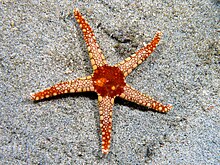
| |
| Fromia monilis | |
| Scientific classification | |
| Domain: | Eukaryota |
| Kingdom: | Animalia |
| Phylum: | Echinodermata |
| Subphylum: | Asterozoa |
| Class: | Asteroidea Blainville,1830 |
| Child taxa andorders | |
| |
Starfishorsea starsarestar-shapedechinodermsbelonging to theclassAsteroidea(/ˌæstəˈrɔɪdiə/). Common usage frequently finds these names being also applied toophiuroids,which are correctly referred to asbrittle starsor basket stars. Starfish are also known asasteroidsdue to being in the class Asteroidea. About 1,900 species of starfish live on theseabedin all the world'soceans,from warm,tropical zonesto frigid,polar regions.They are found from theintertidal zonedown toabyssaldepths, at 6,000 m (20,000 ft) below the surface.
Starfish aremarine invertebrates.They typically have a central disc and usually five arms, though some species have a larger number of arms. The aboral or upper surface may be smooth, granular or spiny, and is covered with overlapping plates. Many species are brightly coloured in various shades of red or orange, while others are blue, grey or brown. Starfish havetube feetoperated by ahydraulic systemand a mouth at the centre of the oral or lower surface. They areopportunisticfeeders and are mostlypredatorsonbenthicinvertebrates. Several species have specialized feeding behaviours including eversion of their stomachs andsuspension feeding.They have complexlife cyclesand can reproduce both sexually andasexually.Most canregeneratedamaged parts or lost arms and they can shed arms as a means of defense. The Asteroidea occupy several significantecological roles.Starfish, such as theochre sea star(Pisaster ochraceus) and thereef sea star(Stichaster australis), have become widely known as examples of thekeystone speciesconcept in ecology. The tropicalcrown-of-thorns starfish(Acanthaster planci) is a voracious predator ofcoralthroughout the Indo-Pacific region, and theNorthern Pacific seastaris on the list of theWorld's 100 Worst Invasive Alien Species.
Thefossilrecord for starfish is ancient, dating back to theOrdovicianaround 450 million years ago, but it is rather sparse, as starfish tend to disintegrate after death. Only theossiclesand spines of the animal are likely to be preserved, making remains hard to locate. With their appealing symmetrical shape, starfish have played a part in literature, legend, design and popular culture. They are sometimes collected as curios, used in design or as logos, and in some cultures, despite possible toxicity, they are eaten.
Anatomy

Most starfish have five arms that radiate from a central disc, but the number varies with the group. Some species have six or seven arms and others have 10–15 arms.[3]The AntarcticLabidiaster annulatuscan have over fifty.[4]
Mapping the expression patterns of genes that express differently across the body axes suggest that one could think of the body of a starfish as a disembodied head walking about the sea floor on its lips. The known markers for trunk structures are expressed only in internal tissues rather than on the surface. Only the front part of the axis, which specifies head-related structures, is represented on the body surface.[5]
Body wall

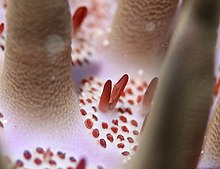

The body wall consists of a thin cuticle, anepidermisconsisting of a single layer of cells, a thickdermisformed ofconnective tissueand a thincoelomicmyoepitheliallayer, which provides the longitudinal and circular musculature. The dermis contains anendoskeletonofcalcium carbonatecomponents known as ossicles. These are honeycombed structures composed ofcalcitemicrocrystals arranged in a lattice.[6]They vary in form, with some bearing external granules, tubercles and spines, but most are tabular plates that fit neatly together in atessellatedmanner and form the main covering of the aboral surface.[7]Some are specialised structures such as themadreporite(the entrance to the water vascular system),pedicellariaeandpaxillae.[6]Pedicellariae are compound ossicles with forceps-like jaws. They remove debris from the body surface and wave around on flexible stalks in response to physical or chemical stimuli while continually making biting movements. They often form clusters surrounding spines.[8][9]Paxillae are umbrella-like structures found on starfish that live buried in sediment. The edges of adjacent paxillae meet to form a false cuticle with a water cavity beneath in which the madreporite and delicate gill structures are protected. All the ossicles, including those projecting externally, are covered by the epidermal layer.[6]
Several groups of starfish, includingValvatidaandForcipulatida,possesspedicellariae.[8]In Forcipulatida, such asAsteriasandPisaster,they occur inpompom-like tufts at the base of each spine, whereas in theGoniasteridae,such asHippasteria phrygiana,the pedicellariae are scattered over the body surface. Some are thought to assist in defence, while others aid in feeding or in the removal of organisms attempting to settle on the starfish's surface.[10]Some species likeLabidiaster annulatus,Rathbunaster californicusandNovodinia antillensisuse their large pedicellariae to capture small fish and crustaceans.[11]
There may also bepapulae,thin-walled protrusions of the body cavity that reach through the body wall and extend into the surrounding water. These serve arespiratoryfunction.[12]The structures are supported by collagen fibres set at right angles to each other and arranged in a three-dimensional web with the ossicles and papulae in theinterstices.This arrangement enables both easy flexion of the arms by the starfish and the rapid onset of stiffness and rigidity required for actions performed under stress.[13]
Water vascular system

The watervascularsystem of the starfish is ahydraulic systemmade up of a network of fluid-filled canals and is concerned with locomotion, adhesion, food manipulation andgas exchange.Water enters the system through themadreporite,a porous, often conspicuous, sieve-like ossicle on the aboral surface. It is linked through a stone canal, often lined with calcareous material, to a ring canal around the mouth opening. A set of radial canals leads off this; one radial canal runs along theambulacralgroove in each arm. There are short lateral canals branching off alternately to either side of the radial canal, each ending in an ampulla. These bulb-shaped organs are joined to tube feet (podia) on the exterior of the animal by short linking canals that pass through ossicles in the ambulacral groove. There are usually two rows of tube feet but in some species, the lateral canals are alternately long and short and there appear to be four rows. The interior of the whole canal system is lined withcilia.[14]
When longitudinal muscles in the ampullae contract, valves in the lateral canals close and water is forced into the tube feet. These extend to contact thesubstrate.Although the tube feet resemble suction cups in appearance, the gripping action is a function of adhesive chemicals rather than suction.[15]Other chemicals and relaxation of the ampullae allow for release from the substrate. The tube feet latch on to surfaces and move in a wave, with one arm section attaching to the surface as another releases.[16][17]Some starfish turn up the tips of their arms while moving which gives maximum exposure of the sensory tube feet and the eyespot to external stimuli.[18]
Having descended frombilateralorganisms, starfish may move in a bilateral fashion, particularly when hunting or in danger. When crawling, certain arms act as the leading arms, while others trail behind.[3][19][9]Most starfish cannot move quickly, a typical speed being that of theleather star(Dermasterias imbricata), which can manage just 15 cm (6 in) in a minute.[20]Some burrowing species from the generaAstropectenandLuidiahave points rather than suckers on their longtube feetand are capable of much more rapid motion, "gliding" across the ocean floor. The sand star (Luidia foliolata) can travel at a speed of 2.8 m (9 ft 2 in) per minute.[21]When a starfish finds itself upside down, two adjacent arms are bent backwards to provide support, the opposite arm is used to stamp the ground while the two remaining arms are raised on either side; finally the stamping arm is released as the starfish turns itself over and recovers its normal stance.[19]
Apart from their function in locomotion, the tube feet act as accessory gills. The water vascular system serves to transportoxygenfrom, and carbon dioxide to, the tube feet and also nutrients from the gut to the muscles involved in locomotion. Fluid movement is bidirectional and initiated bycilia.[14]Gas exchange also takes place through othergillsknown as papulae, which are thin-walled bulges on the aboral surface of the disc and arms. Oxygen is transferred from these to thecoelomic fluid,which acts as the transport medium for gasses. Oxygen dissolved in the water is distributed through the body mainly by the fluid in the main body cavity; the circulatory system may also play a minor role.[22]
Digestive system and excretion

- Pyloric stomach
- Intestine and anus
- Rectal sac
- Stone canal
- Madreporite
- Pyloric caecum
- Digestive glands
- Cardiac stomach
- Gonad
- Radial canal
- Ambulacral ridge
The gut of a starfish occupies most of the disc and extends into the arms. The mouth is located in the centre of the oral surface, where it is surrounded by a toughperistomialmembrane and closed with asphincter.The mouth opens through a shortoesophagusinto astomachdivided by a constriction into a larger,eversiblecardiac portion and a smaller pyloric portion. The cardiac stomach is glandular and pouched, and is supported byligamentsattached to ossicles in the arms so it can be pulled back into position after it has been everted. The pyloric stomach has two extensions into each arm: the pyloric caeca. These are elongated, branched hollow tubes that are lined by a series of glands, which secrete digestiveenzymesand absorb nutrients from the food. A shortintestineandrectumrun from the pyloric stomach to open at a smallanusat the apex of the aboral surface of the disc.[23]
Primitive starfish, such asAstropectenandLuidia,swallow theirpreywhole, and start to digest it in their cardiac stomachs. Shell valves and other inedible materials are ejected through their mouths. The semi-digested fluid is passed into their pyloric stomachs and caeca where digestion continues and absorption ensues.[23]In more advanced species of starfish, the cardiac stomach can be everted from the organism's body to engulf and digest food. When the prey is a clam or otherbivalve,the starfish pulls with its tube feet to separate the two valves slightly, and inserts a small section of its stomach, which releases enzymes to digest the prey. The stomach and the partially digested prey are later retracted into the disc. Here the food is passed on to the pyloric stomach, which always remains inside the disc.[24]The retraction and contraction of the cardiac stomach is activated by aneuropeptideknown as NGFFYamide.[25]
Because of this ability to digest food outside the body, starfish can hunt prey much larger than their mouths. Their diets include clams andoysters,arthropods,smallfishandgastropod molluscs.Some starfish are not purecarnivores,supplementing their diets withalgaeor organic detritus. Some of these species aregrazers,but others trap food particles from the water in stickymucusstrands that are swept towards the mouth alongciliatedgrooves.[23]
The main nitrogenous waste product isammonia.Starfish have no distinct excretory organs; waste ammonia is removed by diffusion through the tube feet and papulae.[22]The body fluid containsphagocyticcells called coelomocytes, which are also found within the hemal and water vascular systems. These cells engulf waste material, and eventually migrate to the tips of the papulae, where a portion of body wall is nipped off and ejected into the surrounding water. Some waste may also be excreted by the pyloric glands and voided with thefaeces.[22]
Starfish do not appear to have any mechanisms forosmoregulation,and keep their body fluids at the same salt concentration as the surrounding water. Although some species can tolerate relatively lowsalinity,the lack of an osmoregulation system probably explains why starfish are not found in fresh water or even in manyestuarineenvironments.[22]
Sensory and nervous systems
Although starfish do not have many well-defined sense organs, they are sensitive to touch, light, temperature, orientation and the status of the water around them. The tube feet, spines and pedicellariae are sensitive to touch. The tube feet, especially those at the tips of the rays, are also sensitive to chemicals, enabling the starfish to detect odour sources such as food.[24]There are eyespots at the ends of the arms, each one made of 80–200 simpleocelli.These are composed ofpigmentedepithelial cells that respond to light and are covered by a thick, transparent cuticle that both protects the ocelli and acts to focus light. Many starfish also possess individualphotoreceptor cellsin other parts of their bodies and respond to light even when their eyespots are covered. Whether they advance or retreat depends on the species.[26]
While a starfish lacks acentralized brain,it has a complexnervous systemwith a nerve ring around the mouth and a radial nerve running along the ambulacral region of each arm parallel to the radial canal. The peripheral nerve system consists of two nerve nets: a sensory system in the epidermis and a motor system in the lining of the coelomic cavity. Neurons passing through the dermis connect the two.[26]The ring nerves and radial nerves have sensory and motor components and coordinate the starfish's balance and directional systems.[12]The sensory component receives input from the sensory organs while the motor nerves control the tube feet and musculature. The starfish does not have the capacity to plan its actions. If one arm detects an attractive odour, it becomes dominant and temporarily over-rides the other arms to initiate movement towards the prey. The mechanism for this is not fully understood.[26]
Circulatory system
The body cavity contains thecirculatoryor haemal system. The vessels form three rings: one around the mouth (the hyponeural haemal ring), another around the digestive system (the gastric ring) and the third near the aboral surface (the genital ring). The heart beats about six times a minute and is at the apex of a vertical channel (the axial vessel) that connects the three rings. At the base of each arm are pairedgonads;a lateral vessel extends from the genital ring past the gonads to the tip of the arm. This vessel has a blind end and there is no continuous circulation of the fluid within it. This liquid does not contain a pigment and has little or no respiratory function but is probably used to transport nutrients around the body.[27]
Secondary metabolites
Starfish produce a large number ofsecondary metabolitesin the form oflipids,includingsteroidalderivatives ofcholesterol,andfatty acidamidesofsphingosine.The steroids are mostlysaponins,known as asterosaponins, and theirsulphatedderivatives. They vary between species and are typically formed from up to six sugar molecules (usuallyglucoseandgalactose) connected by up to threeglycosidicchains. Long-chain fatty acid amides of sphingosine occur frequently and some of them have knownpharmacological activity.Variousceramidesare also known from starfish and a small number ofalkaloidshave also been identified. The functions of these chemicals in the starfish have not been fully investigated but most have roles in defence and communication. Some are feeding deterrents used by the starfish to discourage predation. Others areantifoulantsand supplement the pedicellariae to prevent other organisms from settling on the starfish's aboral surface. Some are alarmpheromonesand escape-eliciting chemicals, the release of which trigger responses inconspecificstarfish but often produce escape responses in potential prey.[28]Research into the efficacy of these compounds for possible pharmacological or industrial use occurs worldwide.[29]
Life cycle
Sexual reproduction
Most species of starfish aregonochorous,there being separate male and female individuals. These are usually not distinguishable externally as the gonads cannot be seen, but their sex is apparent when theyspawn.[30]Some species aresimultaneous hermaphrodites,producing eggs and sperm at the same time, and in a few of these the same gonad, called anovotestis,produces both eggs and sperm.[31]Other starfish aresequential hermaphrodites.Protandrousindividuals of species likeAsterina gibbosastart life as males before changing sex into females as they grow older. In some species such asNepanthia belcheri,a large female cansplit in halfand the resulting offspring are males. When these grow large enough they change back into females.[32]
Each starfish arm contains two gonads that releasegametesthrough openings called gonoducts, located on the central disc between the arms.Fertilizationis generally external but in a few species, internal fertilization takes place. In most species, the buoyant eggs and sperm are simply released into the water (free spawning) and the resultingembryosandlarvaelive as part of theplankton.In others, the eggs may be stuck to the undersides of rocks.[33]In certain species of starfish, the femalesbroodtheir eggs – either by simply enveloping them[33]or by holding them in specialised structures. Brooding may be done in pockets on the starfish's aboral surface,[34][30]inside the pyloric stomach (Leptasterias tenera)[35]or even in the interior of the gonads themselves.[31]Those starfish that brood their eggs by "sitting" on them usually assume a humped posture with their discs raised off the substrate.[36]Pteraster militarisbroods a few of its young and disperses the remaining eggs, that are too numerous to fit into its pouch.[34]In these brooding species, the eggs are relatively large, and supplied withyolk,and they generally develop directly into miniature starfish without an intervening larval stage.[31]The developing young are called lecithotrophic because they obtain their nutrition from the yolk as opposed to "planktotrophic" larvae that feed in thewater column.InParvulastra parvivipara,anintragonadalbrooder, the young starfish obtain nutrients by eating other eggs and embryos in the brood pouch.[37]Brooding is especially common in polar and deep-sea species that live in environments unfavourable for larval development[30]and in smaller species that produce just a few eggs.[38][39]
In the tropics, a plentiful supply of phytoplankton is continuously available for starfish larvae to feed on. Spawning takes place at any time of year, each species having its own characteristic breeding season.[40]In temperate regions, the spring and summer brings an increase in food supplies. The first individual of a species to spawn may release apheromonethat serves to attract other starfish to aggregate and to release their gametes synchronously.[41]In other species, a male and female may come together and form a pair.[42][43]This behaviour is calledpseudocopulation[44]and the male climbs on top, placing his arms between those of the female. When she releases eggs into the water, he is induced to spawn.[41]Starfish may use environmental signals to coordinate the time of spawning (day length to indicate the correct time of the year,[42]dawn or dusk to indicate the correct time of day), and chemical signals to indicate their readiness to breed. In some species, mature females produce chemicals to attract sperm in the sea water.[45]
Larval development
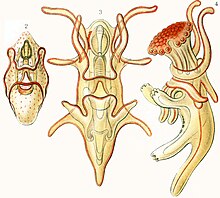
Most starfish embryos hatch at theblastulastage. The original ball of cells develops a lateral pouch, thearchenteron.The entrance to this is known as theblastoporeand it will later develop into the anus—together withchordates,echinodermsaredeuterostomes,meaning the second (deutero) invagination becomes the mouth (stome); members of all otherphylaareprotostomes,and their first invagination becomes the mouth. Another invagination of the surface will fuse with the tip of the archenteron as the mouth while the interior section will become the gut. At the same time, a band ofciliadevelops on the exterior. This enlarges and extends around the surface and eventually onto two developing arm-like outgrowths. At this stage the larva is known as abipinnaria.The cilia are used for locomotion and feeding, their rhythmic beat waftingphytoplanktontowards the mouth.[8]
The next stage in development is abrachiolarialarva and involves the growth of three short, additional arms. These are at the anterior end, surround a sucker and have adhesive cells at their tips. Both bipinnaria and brachiolaria larvae are bilaterally symmetrical. When fully developed, the brachiolaria settles on the seabed and attaches itself with a short stalk formed from the ventral arms and sucker. Metamorphosis now takes place with a radical rearrangement of tissues. The left side of the larval body becomes the oral surface of the juvenile and the right side the aboral surface. Part of the gut is retained, but the mouth and anus move to new positions. Some of the body cavities degenerate but others become the water vascular system and the visceral coelom. The starfish is now pentaradially symmetrical. It casts off its stalk and becomes a free-living juvenile starfish about 1 mm (0.04 in) in diameter. Starfish of the order Paxillosida have no brachiolaria stage, with the bipinnaria larvae settling on the seabed and developing directly into juveniles.[8]
Asexual reproduction

Some species of starfish in the three families Asterinidae, Asteriidae and Solasteridae are able to reproduceasexuallyas adults either byfissionof their central discs[46]or byautotomyof one or more of their arms.[47]Which of these processes occurs depends on the genus. Among starfish that are able to regenerate their whole body from a single arm, some can do so even from fragments just 1 cm (0.4 in) long.[48]Single arms that regenerate a whole individual are called comet forms. The division of the starfish, either across its disc or at the base of the arm, is usually accompanied by a weakness in the structure that provides a fracture zone.[49]
The larvae of several species of starfish can reproduce asexually before they reach maturity.[50]They do this by autotomising some parts of their bodies or bybudding.[51]When such a larva senses that food is plentiful, it takes the path of asexual reproduction rather than normal development.[52]Though this costs it time and energy and delays maturity, it allows a single larva to give rise to multiple adults when the conditions are appropriate.[51]
Regeneration
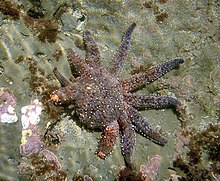
Some species of starfish have the ability toregeneratelost arms and can regrow an entire new limb given time.[48]A few can regrow a complete new disc from a single arm, while others need at least part of the central disc to be attached to the detached part.[22]Regrowth can take several months or years,[48]and starfish are vulnerable to infections during the early stages after the loss of an arm. A separated limb lives off stored nutrients until it regrows a disc and mouth and is able to feed again.[48]Other than fragmentation carried out for the purpose of reproduction, the division of the body may happen inadvertently due to part being detached by a predator, or part may be actively shed by the starfish in an escape response.[22]The loss of parts of the body is achieved by the rapid softening of a special type of connective tissue in response to nervous signals. This type of tissue is calledcatch connective tissueand is found in most echinoderms.[53]An autotomy-promoting factor has been identified which, when injected into another starfish, causes rapid shedding of arms.[54]
Lifespan
The lifespan of a starfish varies considerably between species, generally being longer in larger forms and in those with planktonic larvae. For example,Leptasterias hexactisbroods a small number of large-yolked eggs. It has an adult weight of 20 g (0.7 oz), reaches sexual maturity in two years and lives for about ten years.[8]Pisaster ochraceusreleases a large number of eggs into the sea each year and has an adult weight of up to 800 g (28 oz). It reaches maturity in five years and has a maximum recorded lifespan of 34 years.[8]The average lifespan of a starfish is 35 years, and larger starfish species typically live longer than their smaller counterparts.[55]
Ecology
Distribution and habitat
Echinoderms, including starfish, maintain a delicate internalelectrolytebalance that is in equilibrium with sea water, making it impossible for them to live in afreshwaterhabitat.[16]Starfish species inhabit all of the world's oceans. Habitats range from tropicalcoral reefs,rocky shores,tidal pools,mud, and sand tokelp forests,seagrass meadows[56]and the deep-sea floor down to at least 6,000 m (20,000 ft).[57]The greatest diversity of species occurs in coastal areas.[56]
Diet
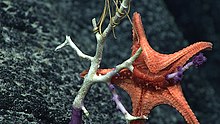
Most species are generalist predators, eatingmicroalgae,sponges,bivalves,snailsand other small animals.[24][58]Thecrown-of-thorns starfishconsumescoralpolyps,[59]while other species aredetritivores,feeding on decomposing organic material and faecal matter.[58][60]A few are suspension feeders, gathering inphytoplankton;HenriciaandEchinasteroften occur in association with sponges, benefiting from the water current they produce.[61]Various species have been shown to be able to absorb organic nutrients from the surrounding water, and this may form a significant portion of their diet.[61]
The processes of feeding and capture may be aided by special parts;Pisaster brevispinus,the short-spined pisaster from theWest Coastof America, can use a set of specialized tube feet to dig itself deep into the soft substrate to extract prey (usuallyclams).[62]Grasping the shellfish, the starfish slowly pries open the prey's shell by wearing out itsadductormuscle, and then inserts its everted stomach into the crack to digest the soft tissues. The gap between the valves need only be a fraction of a millimetre wide for the stomach to gain entry.[16]Cannibalism has been observed in juvenile sea stars as early as four days after metamorphosis.[63]
Ecological impact

Starfish arekeystone speciesin their respective marinecommunities.Their relatively large sizes, diverse diets and ability to adapt to different environments makes them ecologically important.[64]The term "keystone species" was in fact first used byRobert Painein 1966 to describe a starfish,Pisaster ochraceus.[65]When studying the low intertidal coasts ofWashington state,Paine found that predation byP. ochraceuswas a major factor in the diversity of species. Experimental removals of this top predator from a stretch of shoreline resulted in lower species diversity and the eventual domination ofMytilusmussels, which were able to outcompete other organisms for space and resources.[66]Similar results were found in a 1971 study ofStichaster australison the intertidal coast of theSouth IslandofNew Zealand.S. australiswas found to have removed most of a batch of transplanted mussels within two or three months of their placement, while in an area from whichS. australishad been removed, the mussels increased in number dramatically, overwhelming the area and threateningbiodiversity.[67]
The feeding activity of theomnivorousstarfishOreaster reticulatuson sandy and seagrass bottoms in theVirgin Islandsappears to regulate the diversity, distribution and abundance of microorganisms. These starfish engulf piles of sediment removing the surface films and algae adhering to the particles.[68]Organisms that dislike this disturbance are replaced by others better able to rapidly recolonise "clean" sediment. In addition, foraging by these migratory starfish creates diverse patches of organic matter, which may play a role in the distribution and abundance of organisms such as fish, crabs and sea urchins that feed on the sediment.[69]
Starfish sometimes have negative effects on ecosystems. Outbreaks of crown-of-thorns starfish have caused damage to coral reefs in Northeast Australia andFrench Polynesia.[59][70]A study in Polynesia found that coral cover declined drastically with the arrival of migratory starfish in 2006, dropping from 50% to under 5% in three years. This had a cascading effect on the wholebenthiccommunity and reef-feeding fish.[59]Asterias amurensisis one of a few echinoderminvasive species.Its larvae likely arrived inTasmaniafrom central Japan via water discharged from ships in the 1980s. The species has since grown in numbers to the point where they threaten commercially importantbivalvepopulations. As such, they are considered pests,[71]and are on the Invasive Species Specialist Group'slist of the world's 100 worst invasive species.[72]
Sea Stars (starfish) are the main predators of kelp-eating sea urchins. Satellite imagery shows that sea urchin populations have exploded due to starfish mass deaths, and that by 2021, sea urchins have destroyed 95% of California's kelp forests.[73]
Threats
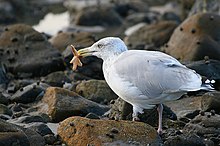
Starfish may be preyed on by conspecifics, sea anemones,[74]other starfish species,tritons,crabs, fish,gullsandsea otters.[38][71][75][76]Their first lines of defence are thesaponinspresent in their body walls, which have unpleasant flavours.[77]Some starfish such asAstropecten polyacanthusalso include powerful toxins such astetrodotoxinamong their chemical armoury, and theslime starcan ooze out large quantities of repellent mucus. They also have body armour in the form of hard plates and spines.[78]Thecrown-of-thorns starfishis particularly unattractive to potential predators, being heavily defended by sharp spines, laced with toxins and sometimes with brightwarning colours.[79]Other species protect their vulnerable tube feet and arm tips by lining their ambulacral grooves with spines and heavily plating their extremities.[78]
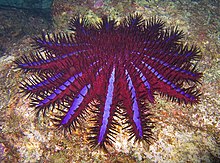
Several species sometimes suffer from awastingcondition caused by bacteria in the genusVibrio;[75]however, a more widespreadwasting disease,causing mass mortalities among starfish, appears sporadically. A paper published in November 2014 revealed the most likely cause of this disease to be a densovirus the authors named sea star-associated densovirus (SSaDV).[80] The protozoanOrchitophrya stellarumis known to infect the gonads of starfish and damage tissue.[75]Starfish are vulnerable to high temperatures. Experiments have shown that the feeding and growth rates ofP. ochraceusreduce greatly when their body temperatures rise above 23 °C (73 °F) and that they die when their temperature rises to 30 °C (86 °F).[81][82]This species has a unique ability to absorb seawater to keep itself cool when it is exposed to sunlight by a receding tide.[83]It also appears to rely on its arms to absorb heat, so as to protect the central disc and vital organs like the stomach.[84]
Starfish and other echinoderms are sensitive tomarine pollution.[85]Thecommon starfishis considered to be abioindicatorfor marine ecosystems.[86]A 2009 study found thatP. ochraceusis unlikely to be affected byocean acidificationas severely as other marine animals withcalcareousskeletons. In other groups, structures made of calcium carbonate are vulnerable to dissolution when thepHis lowered. Researchers found that whenP. ochraceuswere exposed to 21 °C (70 °F) and 770ppmcarbon dioxide(beyond rises expected in the next century), they were relatively unaffected. Their survival is likely due to the nodular nature of their skeletons, which are able to compensate for a shortage of carbonate by growing more fleshy tissue.[87]
Evolution
Fossil record
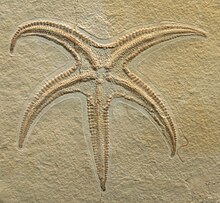

Echinoderms first appeared in thefossil recordin theCambrian.The first known asterozoans were theSomasteroidea,which exhibit characteristics of both groups.[88]Starfish are infrequently found as fossils, possibly because their hard skeletal components separate as the animal decays. Despite this, there are a few places where accumulations of complete skeletal structures occur, fossilized in place inLagerstätten– so-called "starfish beds".[89]
By the latePaleozoic,thecrinoidsandblastoidswere the predominant echinoderms, and some limestones from this period are made almost entirely from fragments from these groups. In the two majorextinction eventsthat occurred during the lateDevonianand latePermian,the blastoids were wiped out and only a few species of crinoids survived.[88]Many starfish species also became extinct in these events, but afterwards the surviving few species diversified rapidly within about sixty million years during theEarly Jurassicand the beginning of theMiddle Jurassic.[90][91]A 2012 study found thatspeciationin starfish can occur rapidly. During the last 6,000 years, divergence in the larval development ofCryptasterina hysteraandCryptasterina pentagonahas taken place, the former adopting internal fertilization and brooding and the latter remaining a broadcast spawner.[92]
Diversity

The scientific name Asteroidea was given to starfish by the French zoologistde Blainvillein 1830.[93]It is derived from theGreekaster,ἀστήρ (a star) and the Greekeidos,εἶδος (form, likeness, appearance).[94]The class Asteroidea belongs to the phylumEchinodermata.As well as the starfish, the echinoderms includesea urchins,sand dollars,brittleandbasket stars,sea cucumbersandcrinoids.The larvae of echinoderms have bilateral symmetry, but duringmetamorphosisthis is replaced withradial symmetry,typicallypentameric.[12]Adult echinoderms are characterized by having awater vascular systemwith externaltube feetand acalcareousendoskeleton consisting ofossiclesconnected by a mesh ofcollagenfibres.[95]Starfish are included in the subphylumAsterozoa,the characteristics of which include a flattened, star-shaped body as adults consisting of a central disc and multiple radiating arms. The subphylum includes the twoclassesof Asteroidea, the starfish, andOphiuroidea,the brittle stars and basket stars. Asteroids have broad-based arms with skeletal support provided by calcareous plates in the body wall[90]while ophiuroids have clearly demarcated slender arms strengthened by paired fused ossicles forming jointed "vertebrae".[96]
The starfish are a large and diverse class with over 1,900 living species. There are sevenextantorders,Brisingida,Forcipulatida,Notomyotida,Paxillosida,Spinulosida,ValvatidaandVelatida[1]and two extinct ones,CalliasterellidaeandTrichasteropsida.[2]Living asteroids, the Neoasteroidea, are morphologically distinct from their forerunners in the Paleozoic. The taxonomy of the group is relatively stable but there is ongoing debate about the status of thePaxillosida,and the deep-water sea daisies, though clearly Asteroidea and currently included inVelatida,do not fit easily in any accepted lineage.Phylogenetic datasuggests that they may be asister group,the Concentricycloidea, to the Neoasteroidea, or that the Velatida themselves may be a sister group.[91]
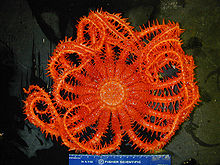
Living groups
- Brisingida(2 families, 17 genera, 111 species)[97]
- Species in this order have a small, inflexible disc and 6–20 long, thin arms, which they use for suspension feeding. They have a single series of marginal plates, a fused ring of disc plates, a reduced number of aboral plates, crossed pedicellariae, and several series of long spines on the arms. They live almost exclusively in deep-sea habitats, although a few live in shallow waters in the Antarctic.[98][99]In some species, the tube feet have rounded tips and lack suckers.[100]
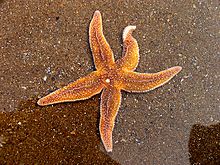
- Forcipulatida(6 families, 63 genera, 269 species)[101]
- Species in this order have distinctive pedicellariae, consisting of a short stalk with three skeletal ossicles. They tend to have robust bodies[102]and have tube feet with flat-tipped suckers usually arranged in four rows.[100]The order includes well-known species from temperate regions, including thecommon starfishof North Atlantic coasts and rock pools, as well as cold-water and abyssal species.[103]
- Notomyotida(1 family, 8 genera, 75 species)[104]
- These starfish are deep-sea dwelling and have particularly flexible arms. The inner dorso-lateral surfaces of the arms contain characteristic longitudinal muscle bands.[1]In some species, the tube feet lack suckers.[100]

- Paxillosida(7 families, 48 genera, 372 species)[105]
- This is a primitive order and members do not extrude their stomach when feeding, lack an anus and have no suckers on their tube feet. Papulae are plentiful on their aboral surface and they possess marginal plates and paxillae. They mostly inhabit soft-bottomed areas of sand or mud.[8]There is no brachiolaria stage in their larval development.[106]The comb starfish (Astropecten polyacanthus) is a member of this order.[107]
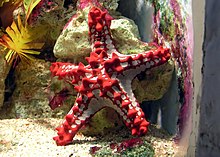
- Spinulosida(1 family, 8 genera, 121 species)[108]
- Most species in this order lack pedicellariae and all have a delicate skeletal arrangement with small or no marginal plates on the disc and arms. They have numerous groups of short spines on the aboral surface.[109][110]This group includes the red starfishEchinaster sepositus.[111]
- Valvatida(16 families, 172 genera, 695 species)[112]
- Most species in this order have five arms and two rows of tube feet with suckers. There are conspicuous marginal plates on the arms and disc. Some species havepaxillaeand in some, the main pedicellariae are clamp-like and recessed into the skeletal plates.[110]This group includes thecushion stars,[113]the leather star[114]and thesea daisies.[115]
- Velatida(4 families, 16 genera, 138 species)[116]
- This order of starfish consists mostly of deep-sea and other cold-water starfish often with a global distribution. The shape is pentagonal or star-shaped with five to fifteen arms. They mostly have poorly developed skeletons with papulae widely distributed on the aboral surface and often spiny pedicellariae.[117]This group includes theslime star.[118]
Extinct groups
Extinct groups within the Asteroidea include:[2]
- †Calliasterellidae,with the type genusCalliasterellafrom the Devonian and Carboniferous[119]
- †Palastericus,a Devonian genus[120]
- †Trichasteropsida,with theTriassicgenusTrichasteropsis(at least 2 species)[2]
Phylogeny
External
Starfish aredeuterostomeanimals, like thechordates.A 2014 analysis of 219 genes from all classes of echinoderms gives the followingphylogenetic tree.[121]The times at which thecladesdiverged are shown under the labels in millions of years ago (mya).
| Bilateria |
| ||||||||||||||||||
Internal
The phylogeny of the Asteroidea has been difficult to resolve, with visible (morphological) features proving inadequate, and the question of whether traditionaltaxaarecladesin doubt.[2]The phylogeny proposed by Gale in 1987 is:[2][122]
| ||||||||||||||||||||||
The phylogeny proposed by Blake in 1987 is:[2][123]
| ||||||||||||||||||||||||||||||||||||||||||||||||||||||||||||||||
Later work making use ofmolecular evidence,with or without the use of morphological evidence, had by 2000 failed to resolve the argument.[2]In 2011, on further molecular evidence, Janies and colleagues noted that the phylogeny of the echinoderms "has proven difficult", and that "the overall phylogeny of extant echinoderms remains sensitive to the choice of analytical methods". They presented a phylogenetic tree for the living Asteroidea only; using the traditional names of starfish orders where possible, and indicating "part of" otherwise, the phylogeny is shown below. The Solasteridae are split from the Velatida, and the old Spinulosida is broken up.[124]
| ||||||||||||||||||||||||||||||||||||||||
|
Notomyotida (not analysed) | |
Human relations
In research

Starfish aredeuterostomes,closely related, together with all other echinoderms, tochordates,and are used in reproductive and developmental studies. Female starfish produce large numbers ofoocytesthat are easily isolated; these can be stored in apre-meiosisphase and stimulated to complete division by the use of1-methyladenine.[125]Starfish oocytes are well suited for this research as they are large and easy to handle, transparent, simple to maintain in sea water at room temperature, and they develop rapidly.[126]Asterina pectinifera,used as amodel organismfor this purpose, is resilient and easy to breed and maintain in the laboratory.[127]
Another area of research is the ability of starfish to regenerate lost body parts. Thestem cellsof adult humans are incapable of much differentiation and understanding the regrowth, repair and cloning processes in starfish may have implications for human medicine.[128]
Starfish also have an unusual ability to expel foreign objects from their bodies, which makes them difficult to tag for research tracking purposes.[129]
In legend and culture

Anaboriginal Australianfable retold by the Welsh school headmasterWilliam Jenkyn Thomas(1870–1959)[130]tells how some animals needed a canoe to cross the ocean. Whale had one but refused to lend it, so Starfish kept him busy, telling him stories and grooming him to remove parasites, while the others stole the canoe. When Whale realized the trick he beat Starfish ragged, which is how Starfish still is today.[131]
In 1900, the scholarEdward TregeardocumentedThe Creation Song,which he describes as "an ancient prayer for the dedication of a high chief" ofHawaii.Among the "uncreated gods" described early in the song are the male Kumulipo ( "Creation" ) and the female Poele, both born in the night, a coral insect, the earthworm, and the starfish.[132]
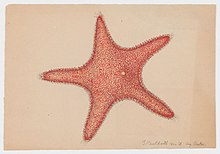
Georg Eberhard Rumpf's 1705The Ambonese Curiosity Cabinetdescribes the tropical varieties ofStella MarinaorBintang Laut,"Sea Star", in Latin andMalayrespectively, known in the waters aroundAmbon.He writes that theHistoire des Antillesreports that when the sea stars "see thunder storms approaching, [they] grab hold of many small stones with their little legs, looking to... hold themselves down as if with anchors".[133]
Starfishis the title of novels byPeter Watts[134]and Jennie Orbell,[135]and in 2012, Alice Addison wrote a non-fiction book titledStarfish: A Year in the Life of Bereavement and Depression.[136]The Starfish and the Spideris a 2006business managementbook by Ori Brafman andRod Beckstrom;its title alludes to the ability of the starfish to regenerate itself because of its decentralized nervous system, and the book suggests ways that a decentralized organisation may flourish.[137]
In theNickelodeonanimatedtelevision seriesSpongeBob SquarePants,theeponymouscharacter's best friend is a dim-witted starfish,Patrick Star.[138]
As food

Starfish are widespread in the oceans, but are only occasionally used as food. There may be good reason for this: the bodies of numerous species are dominated by bony ossicles, and the body wall of many species containssaponins,which have an unpleasant taste,[77]and others containtetrodotoxinswhich are poisonous.[139]Some species that prey onbivalve molluscscan transmitparalytic shellfish poisoning.[140]Georg Eberhard Rumpf found few starfish being used for food in theIndonesianarchipelago, other than as bait in fish traps, but on the island of "Huamobel" [sic] the people cut them up, squeeze out the "black blood" and cook them with sourtamarindleaves; after resting the pieces for a day or two, they remove the outer skin and cook them incoconut milk.[133]Starfish are sometimes eaten in China,[141]Japan[142][143]and in Micronesia.[144]
As collectables
Starfish are in some cases taken from their habitat and sold to tourists assouvenirs,ornaments,curios or for display in aquariums. In particular,Oreaster reticulatus,with its easily accessed habitat and conspicuous coloration, is widely collected in the Caribbean. In the early to mid 20th century, this species was common along the coasts of the West Indies, but collection and trade have severely reduced its numbers. In theState of Florida,O. reticulatusis listed asendangeredand its collection is illegal. Nevertheless, it is still sold throughout its range and beyond.[76]A similar phenomenon exists in the Indo-Pacific for species such asProtoreaster nodosus.[145]

In industry and military history
With its multiple arms, the starfish provides a popular metaphor forcomputer networks,[146]companies[147][148]andsoftwaretools.[149]It is also the name of aseabed imaging systemand company.[150]
Starfish has repeatedly been chosen as a name inmilitary history.Three ships of theRoyal Navyhave borne the name HMSStarfish:anA-class destroyer launched in 1894;[151]anR-class destroyer launched in 1916;[152]andan S-class submarine launched in 1933and lost in 1940.[153]InWorld War II,Starfish siteswere large-scale night-timedecoyscreated duringThe Blitzto simulate burning British cities.[154]Starfish Primewas ahigh-altitude nuclear testconducted by theUnited Stateson 9 July 1962.[155]
References
- ^abcSweet, Elizabeth (22 November 2005)."Fossil Groups: Modern forms: Asteroids: Extant Orders of the Asteroidea".University of Bristol. Archived fromthe originalon 14 July 2007.Retrieved31 May2016.
- ^abcdefghiKnott, Emily (7 October 2004)."Asteroidea. Sea stars and starfishes".Tree of Life web project.Retrieved10 May2013.
- ^abWu, Liang; Ji, Chengcheng; Wang, Sishuo; Lv, Jianhao (2012). "The advantages of the pentameral symmetry of the starfish".arXiv:1202.2219[q-bio.PE].
- ^Prager, Ellen (2011).Sex, Drugs, and Sea Slime: The Oceans' Oddest Creatures and Why They Matter.University of Chicago Press. p. 74.ISBN978-0-2266-7872-6.
- ^Lacalli, T. (2023). A radical evolutionary makeover gave echinoderms their unusual body plan. Nature.https://doi.org/10.1038/d41586-023-03123-1
- ^abcRuppert et al., 2004. p. 877
- ^Sweat, L. H. (31 October 2012)."Glossary of terms: Phylum Echinodermata".Smithsonian Institution.Retrieved12 May2013.
- ^abcdefgRuppert et al, 2004. pp. 887–889
- ^abCarefoot, Tom."Pedicellariae".Sea Stars: Predators & Defenses.A Snail's Odyssey. Archived fromthe originalon 16 March 2013.Retrieved11 May2013.
- ^Barnes, R. S. K.; Callow, P.; Olive, P. J. W. (1988).The Invertebrates: a new synthesis.Oxford: Blackwell Scientific Publications. pp. 158–160.ISBN978-0-632-03125-2.
- ^Lawrence, J. M. (24 January 2013). "The Asteroid Arm".Starfish: Biology and Ecology of the Asteroidea.JHU Press. pp. 15–23.ISBN9781421407876.in Lawrence (2013)
- ^abcFox, Richard (25 May 2007)."Asterias forbesi".Invertebrate Anatomy OnLine.Lander University.Retrieved19 May2012.
- ^O'Neill, P. (1989). "Structure and mechanics of starfish body wall".Journal of Experimental Biology.147:53–89.doi:10.1242/jeb.147.1.53.PMID2614339.
- ^abRuppert et al., 2004. pp. 879–883
- ^Hennebert, E.; Santos, R.; Flammang, P. (2012)."Echinoderms don't suck: evidence against the involvement of suction in tube foot attachment"(PDF).Zoosymposia.1:25–32.doi:10.11646/zoosymposia.7.1.3.
- ^abcDorit, R. L.; Walker, W. F.; Barnes, R. D. (1991).Zoology.Saunders College Publishing. p.782.ISBN978-0-03-030504-7.
- ^Cavey, Michael J.; Wood, Richard L. (1981). "Specializations for excitation-contraction coupling in the podial retractor cells of the starfishStylasterias forreri".Cell and Tissue Research.218(3): 475–485.doi:10.1007/BF00210108.PMID7196288.S2CID21844282.
- ^Carefoot, Tom."Tube feet".Sea Stars: Locomotion.A Snail's Odyssey. Archived fromthe originalon 21 October 2013.Retrieved11 May2013.
- ^abChengcheng, J.; Wu, L.; Zhoa, W.; Wang, S.; Lv, J. (2012)."Echinoderms have bilateral tendencies".PLOS ONE.7(1): e28978.arXiv:1202.4214.Bibcode:2012PLoSO...728978J.doi:10.1371/journal.pone.0028978.PMC3256158.PMID22247765.
- ^"Leather star -Dermasterias imbricata".Sea Stars of the Pacific Northwest. Archived fromthe originalon 9 September 2012.Retrieved27 September2012.
- ^McDaniel, Daniel."Sand star -Luidia foliolata".Sea Stars of the Pacific Northwest. Archived fromthe originalon 9 September 2012.Retrieved26 September2012.
- ^abcdefRuppert et al., 2004. pp. 886–887
- ^abcRuppert et al., 2004. p. 885
- ^abcCarefoot, Tom."Adult feeding".Sea Stars: Feeding, growth, & regeneration.A Snail's Odyssey. Archived fromthe originalon 12 May 2013.Retrieved13 July2013.
- ^Semmens, Dean C.; Dane, Robyn E.; Pancholi, Mahesh R.; Slade, Susan E.; Scrivens, James H.; Elphick, Maurice R. (2013)."Discovery of a novel neurophysin-associated neuropeptide that triggers cardiac stomach contraction and retraction in starfish".Journal of Experimental Biology.216(21): 4047–4053.doi:10.1242/jeb.092171.PMID23913946.S2CID19175526.
- ^abcRuppert et al., 2004. pp. 883–884
- ^Ruppert et al., 2004. p. 886
- ^McClintock, James B.; Amsler, Charles D.; Baker, Bill J. (2013)."8: Chemistry and Ecological Role of Starfish Secondary Metabolites".In Lawrence, John M. (ed.).Starfish: Biology and Ecology of the Asteroidea.JHU Press.ISBN978-1-4214-1045-6.
- ^Zhang, Wen; Guo, Yue-Wei; Gu, Yucheng (2006). "Secondary metabolites from the South China Sea invertebrates: chemistry and biological activity".Current Medicinal Chemistry.13(17): 2041–2090.doi:10.2174/092986706777584960.PMID16842196.
- ^abcRuppert et al., 2004. pp. 887–888
- ^abcByrne, Maria (2005). "Viviparity in the sea starCryptasterina hystera(Asterinidae): conserved and modified features in reproduction and development ".Biological Bulletin.208(2): 81–91.CiteSeerX10.1.1.334.314.doi:10.2307/3593116.JSTOR3593116.PMID15837957.S2CID16302535.
- ^Ottesen, P. O.; Lucas, J. S. (1982). "Divide or broadcast: interrelation of asexual and sexual reproduction in a population of the fissiparous hermaphroditic seastarNepanthia belcheri(Asteroidea: Asterinidae) ".Marine Biology.69(3): 223–233.Bibcode:1982MarBi..69..223O.doi:10.1007/BF00397488.S2CID84885523.
- ^abCrump, R. G.; Emson, R. H. (1983)."The natural history, life history and ecology of the two British species ofAsterina"(PDF).Field Studies.5(5): 867–882.Retrieved27 July2011.
- ^abMcClary, D. J.; Mladenov, P. V. (1989). "Reproductive pattern in the brooding and broadcasting sea starPteraster militaris".Marine Biology.103(4): 531–540.Bibcode:1989MarBi.103..531M.doi:10.1007/BF00399585.S2CID84867808.
- ^Hendler, Gordon; Franz, David R. (1982)."The biology of a brooding seastar,Leptasterias tenera,in Block Island ".Biological Bulletin.162(3): 273–289.doi:10.2307/1540983.JSTOR1540983.
- ^Chia, Fu-Shiang (1966)."Brooding behavior of a six-rayed starfish,Leptasterias hexactis".Biological Bulletin.130(3): 304–315.doi:10.2307/1539738.JSTOR1539738.
- ^Byrne, M. (1996)."Viviparity and intragonadal cannibalism in the diminutive sea starsPatiriella viviparaandP. parvivipara(family Asterinidae) ".Marine Biology.125(3): 551–567.Bibcode:1996MarBi.125..551B.doi:10.1007/BF00353268.S2CID83110156.
- ^abGaymer, C. F.; Himmelman, J. H. (2014). "Leptasterias polaris".Starfish: Biology and Ecology of the Asteroidea.Vol. 10. pp. 182–84.Bibcode:2014MBioR..10...93V.doi:10.1080/17451000.2013.820323.in Lawrence (2013)
- ^Mercier, A.; Hamel J-F. (2014). "Reproduction in Asteroidea".Starfish: Biology and Ecology of the Asteroidea.Vol. 10. p. 37.Bibcode:2014MBioR..10...93V.doi:10.1080/17451000.2013.820323.in Lawrence (2013)
- ^Thorson, Gunnar (1950). "Reproductive and larval ecology of marine bottom invertebrates".Biological Reviews.25(1): 1–45.doi:10.1111/j.1469-185X.1950.tb00585.x.PMID24537188.S2CID43678161.
- ^abBeach, D. H.; Hanscomb, N. J.; Ormond, R. F. G. (1975). "Spawning pheromone in crown-of-thorns starfish".Nature.254(5496): 135–136.Bibcode:1975Natur.254..135B.doi:10.1038/254135a0.PMID1117997.S2CID4278163.
- ^abBos A.R.; G.S. Gumanao; B. Mueller; M.M. Saceda (2013)."Size at maturation, sex differences, and pair density during the mating season of the Indo-Pacific beach starArchaster typicus(Echinodermata: Asteroidea) in the Philippines ".Invertebrate Reproduction and Development.57(2): 113–119.Bibcode:2013InvRD..57..113B.doi:10.1080/07924259.2012.689264.S2CID84274160.
- ^Run, J. -Q.; Chen, C. -P.; Chang, K. -H.; Chia, F. -S. (1988). "Mating behaviour and reproductive cycle ofArchaster typicus(Echinodermata: Asteroidea) ".Marine Biology.99(2): 247–253.Bibcode:1988MarBi..99..247R.doi:10.1007/BF00391987.ISSN0025-3162.S2CID84566087.
- ^Keesing, John K.; Graham, Fiona; Irvine, Tennille R.; Crossing, Ryan (2011). "Synchronous aggregated pseudo-copulation of the sea starArchaster angulatusMüller & Troschel, 1842 (Echinodermata: Asteroidea) and its reproductive cycle in south-western Australia ".Marine Biology.158(5): 1163–1173.Bibcode:2011MarBi.158.1163K.doi:10.1007/s00227-011-1638-2.S2CID84926100.
- ^Miller, Richard L. (12 October 1989). "Evidence for the presence of sexual pheromones in free-spawning starfish".Journal of Experimental Marine Biology and Ecology.130(3): 205–221.Bibcode:1989JEMBE.130..205M.doi:10.1016/0022-0981(89)90164-0.
- ^Achituv, Y.; Sher, E. (1991)."Sexual reproduction and fission in the sea starAsterina burtonifrom the Mediterranean coast of Israel ".Bulletin of Marine Science.48(3): 670–679.
- ^Rubilar, Tamara; Pastor, Catalina; Diaz de Vivar, Enriqueta (30 January 2006)."Timing of fission in the starfish Allostichaster capensis (Echinodermata:Asteroidea) in laboratory"(PDF).Revista de Biología Tropical(53 (Supplement 3)): 299–303.
- ^abcdEdmondson, C. H. (1935)."Autotomy and regeneration of Hawaiian starfishes"(PDF).Bishop Museum Occasional Papers.11(8): 3–20.
- ^Carnevali, Candia; Bonasoro F. (2001). "Introduction to the biology of regeneration in echinoderms".Microscopy Research and Technique.55(6): 365–368.doi:10.1002/jemt.1184.PMID11782068.S2CID31052874.
- ^Eaves, Alexandra A.; Palmer, A. Richard (2003)."Reproduction: widespread cloning in echinoderm larvae".Nature.425(6954): 146.Bibcode:2003Natur.425..146E.doi:10.1038/425146a.ISSN0028-0836.PMID12968170.S2CID4430104.
- ^abJaeckle, William B. (1994)."Multiple modes of asexual reproduction by tropical and subtropical sea star larvae: an unusual adaptation for genet dispersal and survival".Biological Bulletin.186(1): 62–71.doi:10.2307/1542036.JSTOR1542036.PMID29283296.
- ^Vickery, M. S.; McClintock, J. B. (1 December 2000)."Effects of food concentration and availability on the incidence of cloning in planktotrophic larvae of the sea starPisaster ochraceus".The Biological Bulletin.199(3): 298–304.doi:10.2307/1543186.JSTOR1543186.PMID11147710.
- ^Hayashi, Yutaka; Motokawa, Tatsuo (1986)."Effects of ionic environment on viscosity of catch connective tissue in holothurian body wall".Journal of Experimental Biology.125(1): 71–84.doi:10.1242/jeb.125.1.71.ISSN0022-0949.
- ^Mladenov, Philip V.; Igdoura, Suleiman; Asotra, Satish; Burke, Robert D. (1989)."Purification and partial characterization of an autotomy-promoting factor from the sea starPycnopodia helianthoides".Biological Bulletin.176(2): 169–175.doi:10.2307/1541585.ISSN0006-3185.JSTOR1541585.Archived fromthe originalon 23 September 2015.Retrieved12 July2013.
- ^template, barebone (4 September 2019)."Fun facts about Starfish".National Marine Aquarium.Retrieved17 April2024.
- ^ab"Asteroidea (Sea Stars)".Encyclopedia.Grzimek's Animal Life Encyclopedia. 2004.Retrieved14 July2012.
- ^Mah, Christopher; Nizinski, Martha; Lundsten, Lonny (2010)."Phylogenetic revision of the Hippasterinae (Goniasteridae; Asteroidea): systematics of deep sea corallivores, including one new genus and three new species".Zoological Journal of the Linnean Society.160(2): 266–301.doi:10.1111/j.1096-3642.2010.00638.x.
- ^abPearse, J. S. (2014). "Odontaster validus".Starfish: Biology and Ecology of the Asteroidea.Vol. 10. pp. 124–25.Bibcode:2014MBioR..10...93V.doi:10.1080/17451000.2013.820323.in Lawrence (2013)
- ^abcKayal, Mohsen; Vercelloni, Julie; Lison de Loma, Thierry; Bosserelle, Pauline; Chancerelle, Yannick; Geoffroy, Sylvie; Stievenart, Céline; Michonneau, François; Penin, Lucie; Planes, Serge; Adjeroud, Mehdi (2012). Fulton, Christopher (ed.)."Predator crown-of-thorns starfish (Acanthaster planci) outbreak, mass mortality of corals, and cascading effects on reef fish and benthic communities ".PLOS ONE.7(10): e47363.Bibcode:2012PLoSO...747363K.doi:10.1371/journal.pone.0047363.PMC3466260.PMID23056635.
- ^Turner, R. L. (2014). "Echinaster".Starfish: Biology and Ecology of the Asteroidea.Vol. 10. pp. 206–207.Bibcode:2014MBioR..10...93V.doi:10.1080/17451000.2013.820323.in Lawrence (2012)
- ^abFlorkin, Marcel (2012).Chemical Zoology V3: Echinnodermata, Nematoda, and Acanthocephala.Elsevier. pp. 75–77.ISBN978-0-323-14311-0.
- ^Nybakken, James W.; Bertness, Mark D. (1997).Marine Biology: An Ecological Approach.Addison-Wesley Educational Publishers. p. 174.ISBN978-0-8053-4582-7.
- ^McClain, Joseph (5 April 2021)."Researcher reports cannibalistic echinoderm underwater dwellers".phys.org.Retrieved6 April2021.
- ^Menage, B. A.; Sanford, E. (2014). "Ecological Role of Sea Stars from Populations to Meta-ecosystems".Starfish: Biology and Ecology of the Asteroidea.Vol. 10. p. 67.Bibcode:2014MBioR..10...93V.doi:10.1080/17451000.2013.820323.in Lawrence (2013)
- ^Wagner, S. C. (2012)."Keystone Species".Nature Education Knowledge.Retrieved16 May2013.
- ^Paine, R. T. (1966). "Food web complexity and species diversity".American Naturalist.100(190): 65–75.doi:10.1086/282400.JSTOR2459379.S2CID85265656.
- ^Paine, R. T. (1971). "A short-term experimental investigation of resource partitioning in a New Zealand rocky intertidal habitat".Ecology.52(6): 1096–1106.Bibcode:1971Ecol...52.1096P.doi:10.2307/1933819.JSTOR1933819.
- ^Wullf, L. (1995). "Sponge-feeding by the Caribbean starfishOreaster reticulatus".Marine Biology.123(2): 313–325.Bibcode:1995MarBi.123..313W.doi:10.1007/BF00353623.S2CID85726832.
- ^Scheibling, R. E. (1980)."Dynamics and feeding activity of high-density aggregations ofOreaster reticulatus(Echinodermata: Asteroidea) in a sand patch habitat ".Marine Ecology Progress Series.2:321–27.Bibcode:1980MEPS....2..321S.doi:10.3354/meps002321.
- ^Brodie J, Fabricius K, De'ath G, Okaji K (2005). "Are increased nutrient inputs responsible for more outbreaks of crown-of-thorns starfish? An appraisal of the evidence".Marine Pollution Bulletin.51(1–4): 266–78.Bibcode:2005MarPB..51..266B.doi:10.1016/j.marpolbul.2004.10.035.PMID15757727.
- ^abByrne, M.; O'Hara, T. D.; Lawrence, J. M. (2014). "Asterias amurensis".Starfish: Biology and Ecology of the Asteroidea.Vol. 10. pp. 177–179.Bibcode:2014MBioR..10...93V.doi:10.1080/17451000.2013.820323.in Lawrence (2013)
- ^"100 of the World's Worst Invasive Alien Species".Global Invasive Species Database. Archived fromthe originalon 29 April 2015.Retrieved16 July2010.
- ^Whang, Oliver (5 December 2022)."The Missing Mammal (the extinct: Steller's sea cow) That May Have Shaped California's Kelp Forests".The New York Times.Retrieved5 December2022.
- ^"Fact Sheet: Sea Anemones".Marine Biological Association. 21 February 2017. Archived fromthe originalon 24 December 2019.Retrieved10 June2019.
- ^abcRobles, C. (2014). "Pisaster ochraceus".Starfish: Biology and Ecology of the Asteroidea.Vol. 10. pp. 166–167.Bibcode:2014MBioR..10...93V.doi:10.1080/17451000.2013.820323.in Lawrence (2013)
- ^abScheibling, R. E. (2014). "Oreaster reticulatus".Starfish: Biology and Ecology of the Asteroidea.Vol. 10. p. 150.Bibcode:2014MBioR..10...93V.doi:10.1080/17451000.2013.820323.in Lawrence (2013)
- ^abAndersson L, Bohlin L, Iorizzi M, Riccio R, Minale L, Moreno-López W; Bohlin; Iorizzi; Riccio; Minale; Moreno-López (1989). "Biological activity of saponins and saponin-like compounds from starfish and brittle-stars".Toxicon.27(2): 179–88.Bibcode:1989Txcn...27..179A.doi:10.1016/0041-0101(89)90131-1.PMID2718189.
{{cite journal}}:CS1 maint: multiple names: authors list (link) - ^abMah, Christopher (20 April 2010)."Sea star defense".The Echinoblog.Retrieved30 May2013.
- ^Shedd, John G. (2006)."Crown of Thorns Sea Star".Shedd Aquarium. Archived fromthe originalon 22 February 2014.Retrieved22 May2013.
- ^Hewson, Ian; Button, Jason B.; Gudenkauf, Brent M.; Miner, Benjamin; Newton, Alisa L.; Gaydos, Joseph K.; Wynne, Janna; Groves, Cathy L.; et al. (2014)."Densovirus associated with sea-star wasting disease and mass mortality".PNAS.111(48): 17278–17283.Bibcode:2014PNAS..11117278H.doi:10.1073/pnas.1416625111.PMC4260605.PMID25404293.
- ^Peters, L. E.; Mouchka M. E.; Milston-Clements, R. H.; Momoda, T. S.; Menge, B. A. (2008). "Effects of environmental stress on intertidal mussels and their sea star predators".Oecologia.156(3): 671–680.Bibcode:2008Oecol.156..671P.doi:10.1007/s00442-008-1018-x.PMID18347815.S2CID19557104.
- ^Pincebourde, S.; Sanford, E.; Helmuth, B. (2008)."Body temperature during low tide alters the feeding performance of a top intertidal predator".Limnology and Oceanography.53(4): 1562–1573.Bibcode:2008LimOc..53.1562P.doi:10.4319/lo.2008.53.4.1562.S2CID1043536.
- ^Pincebourde, S.; Sanford, E.; Helmuth, B. (2009)."An intertidal sea star adjusts thermal inertia to avoid extreme body temperatures".The American Naturalist.174(6): 890–897.doi:10.1086/648065.JSTOR10.1086/648065.PMID19827942.S2CID13862880.
- ^Pincebourde, S.; Sanford, E.; Helmuth, B. (2013)."Survival and arm abscission are linked to regional heterothermy in an intertidal sea star".Journal of Experimental Biology.216(12): 2183–2191.doi:10.1242/jeb.083881.PMID23720798.S2CID4514808.
- ^Newton, L. C.; McKenzie, J. D. (1995). "Echinoderms and oil pollution: A potential stress assay using bacterial symbionts".Marine Pollution Bulletin.31(4–12): 453–456.Bibcode:1995MarPB..31..453N.doi:10.1016/0025-326X(95)00168-M.
- ^Temara, A.; Skei, J.M.; Gillan, D.; Warnau, M.; Jangoux, M.; Dubois, Ph. (1998). "Validation of the asteroidAsterias rubens(Echinodermata) as a bioindicator of spatial and temporal trends of Pb, Cd, and Zn contamination in the field ".Marine Environmental Research.45(4–5): 341–56.Bibcode:1998MarER..45..341T.doi:10.1016/S0141-1136(98)00026-9.
- ^Gooding, Rebecca A.; Harley, Christopher D. G.; Tang, Emily (2009)."Elevated water temperature and carbon dioxide concentration increase the growth of a keystone echinoderm".Proceedings of the National Academy of Sciences.106(23): 9316–9321.Bibcode:2009PNAS..106.9316G.doi:10.1073/pnas.0811143106.PMC2695056.PMID19470464.
- ^abWagonner, Ben (1994)."Echinodermata: Fossil Record".Echinodermata.The Museum of Paleontology of The University of California at Berkeley.Retrieved31 May2013.
- ^Benton, Michael J.;Harper, David A. T.(2013)."15. Echinoderms".Introduction to Paleobiology and the Fossil Record.Wiley.ISBN978-1-118-68540-2.
- ^abKnott, Emily (2004)."Asteroidea: Sea stars and starfishes".Tree of Life web project.Retrieved19 October2012.
- ^abMah, Christopher L.; Blake, Daniel B. (2012). Badger, Jonathan H (ed.)."Global diversity and phylogeny of the Asteroidea (Echinodermata)".PLOS ONE.7(4): e35644.Bibcode:2012PLoSO...735644M.doi:10.1371/journal.pone.0035644.PMC3338738.PMID22563389.
- ^Purit, J. B.; Keever, C. C.; Addison, J. A.; Byrne, M.; Hart, M. W.; Grosberg, R. K.; Toonen, R. J. (2012)."Extraordinarily rapid life-history divergence betweenCryptasterinasea star species ".Proceedings of the Royal Society B: Biological Sciences.279(1744): 3914–3922.doi:10.1098/rspb.2012.1343.PMC3427584.PMID22810427.
- ^Hansson, Hans (2013)."Asteroidea".WoRMS.World Register of Marine Species.Retrieved19 July2013.
- ^"Etymology of the Latin word Asteroidea".MyEtymology.2008. Archived from the original on 21 October 2013.Retrieved19 July2013.
{{cite web}}:CS1 maint: unfit URL (link) - ^Wray, Gregory A. (1999)."Echinodermata: Spiny-skinned animals: sea urchins, starfish, and their allies".Tree of Life web project.Retrieved19 October2012.
- ^Stöhr, S.; O'Hara, T."World Ophiuroidea Database".Retrieved19 October2012.
- ^Mah, Christopher (2012)."Brisingida".WoRMS.World Register of Marine Species.Retrieved15 September2012.
- ^Downey, Maureen E. (1986)."Revision of the Atlantic Brisingida (Echinodermata: Asteroidea), with description of a new genus and family"(PDF).Smithsonian Contributions to Zoology(435). Smithsonian Institution Press: 1–57.doi:10.5479/si.00810282.435.Archived fromthe original(PDF)on 27 February 2012.Retrieved18 October2012.
- ^Mah, Christopher."Brisingida".Access Science: Encyclopedia.McGraw-Hill. Archived fromthe originalon 30 October 2012.Retrieved15 September2012.
- ^abcVickery, Minako S.; McClintock, James B. (2000)."Comparative morphology of tube feet among the Asteroidea: phylogenetic implications".Integrative and Comparative Biology.40(3): 355–364.doi:10.1093/icb/40.3.355.
- ^Mah, Christopher (2012)."Forcipulatida".WoRMS.World Register of Marine Species.Retrieved15 September2012.
- ^Barnes, Robert D. (1982).Invertebrate Zoology.Holt-Saunders International. p. 948.ISBN978-0-03-056747-6.
- ^Mah, Christopher."Forcipulatida".Access Science: Encyclopedia.McGraw-Hill. Archived fromthe originalon 30 October 2012.Retrieved15 September2012.
- ^Mah, Christopher (2012)."Notomyotida".WoRMS.World Register of Marine Species.Retrieved15 September2012.
- ^Mah, Christopher (2012)."Paxillosida".WoRMS.World Register of Marine Species.Retrieved15 September2012.
- ^Matsubara, M.; Komatsu, M.; Araki, T.; Asakawa, S.; Yokobori, S.-I.; Watanabe, K.; Wada, H. (2005). "The phylogenetic status of Paxillosida (Asteroidea) based on complete mitochondrial DNA sequences".Molecular Genetics and Evolution.36(3): 598–605.Bibcode:2005MolPE..36..598M.doi:10.1016/j.ympev.2005.03.018.PMID15878829.
- ^Mah, Christopher (2012)."Astropecten polyacanthusMüller & Troschel, 1842 ".WoRMS.World Register of Marine Species.Retrieved6 July2013.
- ^Mah, Christopher (2012)."Spinulosida".WoRMS.World Register of Marine Species.Retrieved15 September2012.
- ^"Spinulosida".Access Science: Encyclopedia.McGraw-Hill. Archived fromthe originalon 30 October 2012.Retrieved15 September2012.
- ^abBlake, Daniel B. (1981). "A reassessment of the sea-star orders Valvatida and Spinulosida".Journal of Natural History.15(3): 375–394.Bibcode:1981JNatH..15..375B.doi:10.1080/00222938100770291.
- ^Mah, Christopher (2012)."Echinaster (Echinaster) sepositus(Retzius, 1783) ".WoRMS.World Register of Marine Species.Retrieved6 July2013.
- ^Mah, Christopher (2012)."Valvatida".WoRMS.World Register of Marine Species.Retrieved15 September2012.
- ^Mah, Christopher (2012)."Culcita(Agassiz, 1836) ".WoRMS.World Register of Marine Species.Retrieved6 July2013.
- ^Mah, Christopher (2012)."Dermasterias imbricata(Grube, 1857) ".WoRMS.World Register of Marine Species.Retrieved6 July2013.
- ^Mah, Christopher (2012)."Xyloplax Baker,Rowe & Clark, 1986 ".WoRMS.World Register of Marine Species.Retrieved6 July2013.
- ^Mah, Christopher (2012)."Velatida".WoRMS.World Register of Marine Species.Retrieved15 September2012.
- ^Mah, Christopher."Velatida".Access Science: Encyclopedia.McGraw-Hill. Archived fromthe originalon 30 October 2012.Retrieved15 September2012.
- ^Mah, Christopher (2012)."Pteraster tesselatusIves, 1888 ".WoRMS.World Register of Marine Species.Retrieved6 July2013.
- ^"Family Calliasterellidae".Paleobiology Database.Retrieved10 May2013.
- ^Walker, Cyril,Ward, DavidFossils:SmithsonianHandbook,ISBN0-7894-8984-8(2002, paperback, revisited),ISBN1-56458-074-1(1992, 1st edition). Page 186
- ^Telford, M. J.; Lowe, C. J.; Cameron, C. B.; Ortega-Martinez, O.; Aronowicz, J.; Oliveri, P.; Copley, R. R. (2014)."Phylogenomic analysis of echinoderm class relationships supports Asterozoa".Proceedings of the Royal Society B: Biological Sciences.281(1786): 20140479.doi:10.1098/rspb.2014.0479.PMC4046411.PMID24850925.
- ^Gale, A. S. (1987). "Phylogeny and classification of the Asteroidea (Echinodermata)".Zoological Journal of the Linnean Society.89(2): 107–132.doi:10.1111/j.1096-3642.1987.tb00652.x.
- ^Blake, D. B. (1987). "A classification and phylogeny of post-Paleozoic sea stars (Asteroidea: Echinodermata)".Journal of Natural History.21(2): 481–528.Bibcode:1987JNatH..21..481B.doi:10.1080/00222938700771141.
- ^Janies, Daniel A.; Voight, Janet R.; Daly, Marymegan (2011)."Echinoderm phylogeny includingXyloplax,a progenetic asteroid ".Syst. Biol.60(4): 420–438.doi:10.1093/sysbio/syr044.PMID21525529.
- ^Wessel, G. M.; Reich, A. M.; Klatsky, P. C. (2010)."Use of sea stars to study basic reproductive processes".Systems Biology in Reproductive Medicine.56(3): 236–245.doi:10.3109/19396361003674879.PMC3983664.PMID20536323.
- ^Lenart Group."Cytoskeletal dynamics and function in oocytes".European Molecular Biology Laboratory. Archived fromthe originalon 1 August 2014.Retrieved22 July2013.
- ^Davydov, P. V.; Shubravyi, O. I.; Vassetzky, S. G. (1990).Animal Species for Developmental Studies: The StarfishAsterina pectinifera.Springer US. pp. 287–311.doi:10.1007/978-1-4613-0503-3.ISBN978-1-4612-7839-9.S2CID42046815.
- ^Friedman, Rachel S. C.; Krause, Diane S. (2009). "Regeneration and repair: new findings in stem cell research and ageing".Annals of the New York Academy of Sciences.1172(1): 88–94.doi:10.1111/j.1749-6632.2009.04411.x.PMID19735242.S2CID755324.
- ^Ted Ranosa (19 June 2015)."Starfish Shows Off Strange Ability To Expel Foreign Objects Through Skin".Tech Times, Science.Archivedfrom the original on 1 January 2016.
- ^"William Jenkyn Thomas, M.A".The Aberdare Boys' Grammar School. Archived fromthe originalon 6 June 2014.Retrieved12 May2013.
- ^Thomas, William Jenkyn (1943).Some Myths and Legends of the Australian Aborigines.Whitcombe & Tombs. pp. 21–28.
- ^Tregear, Edward(1900).""The Creation Song" of Hawaii ".The Journal of the Polynesian Society.9(1): 38–46. Archived fromthe originalon 12 February 2016.Retrieved13 May2013.
- ^abRumphius, Georgious Everhardus (= Georg Eberhard Rumpf); Beekman, E.M. (trans.) (1999) [1705].The Ambonese Curiosity Cabinet (original title: Amboinsche Rariteitkamer).Yale University Press. p. 68.ISBN978-0-300-07534-2.
{{cite book}}:CS1 maint: multiple names: authors list (link) - ^Watts, Peter (2008).Starfish (Rifters Trilogy).Tor.ISBN978-0-7653-1596-0.
- ^Orbell, Jennie (2012).Starfish.Tedge Press.ISBN978-1-5147-8841-7.
- ^Addison, Alice (2012).Starfish: A Year in the Life of Bereavement and Depression.Chipmunkapublishing.ISBN978-1-8499-1995-1.
- ^Brafman, Ori; Beckstrom, Rod (2006).The Starfish and the Spider: The Unstoppable Power of Leaderless Organizations.Penguin.ISBN978-1-59184-183-8.
- ^"SpongeBob SquarePants".Patrick.Nickelodeon. 2013. Archived fromthe originalon 7 October 2014.Retrieved16 May2013.
- ^Lin SJ, Hwang DF; Hwang (April 2001). "Possible source of tetrodotoxin in the starfish Astropecten scoparius".Toxicon.39(4): 573–9.Bibcode:2001Txcn...39..573L.doi:10.1016/S0041-0101(00)00171-9.PMID11024497.
- ^Asakawa, M.; Nishimura, F.; Miyazawa, K.; Noguchi, T. (1997). "Occurrence of paralytic shellfish poison in the starfishAsterias amurensisin Kure Bay, Hiroshima Prefecture, Japan ".Toxicon.35(7): 1081–1087.Bibcode:1997Txcn...35.1081A.doi:10.1016/S0041-0101(96)00216-4.PMID9248006.
- ^"Indulging in Exotic Cuisine in Beijing".The China Guide. 2011. Archived fromthe originalon 3 March 2014.Retrieved28 February2014.
- ^Amakusa TV Co. Ltd. (7 August 2011)."Cooking Starfish in Japan".ebook10005.Amakusa TV.Retrieved18 May2013.
- ^"Pouch A"(in Japanese). Kenko. Archived fromthe originalon 3 August 2014.Retrieved18 May2013.
- ^Johannes, Robert Earle (1981).Words of the Lagoon: Fishing and Marine Lore in the Palau District of Micronesia.University of California Press. pp.87.
- ^Bos, A. R.; Gumanao, G. S.; Alipoyo, J. C. E.; Cardona, L. T. (2008)."Population dynamics, reproduction and growth of the Indo-Pacific horned sea star,Protoreaster nodosus(Echinodermata; Asteroidea) ".Marine Biology.156(1): 55–63.Bibcode:2008MarBi.156...55B.doi:10.1007/s00227-008-1064-2.hdl:2066/72067.S2CID84521816.
- ^"Starfish".Larva Labs. Archived fromthe originalon 28 July 2014.Retrieved10 May2013.
- ^Starfish Associates LLC (2005–2013)."Starfish".Starfish Associates.Retrieved10 May2013.
- ^"Motorola to Acquire Starfish".Motorola. 14 July 1998. Archived fromthe originalon 7 February 2012.Retrieved11 May2013.(See alsoStarfish Software.)
- ^"Starfish".Duke Startup Challenge.Duke University. Archived fromthe originalon 7 March 2013.Retrieved10 May2013.
- ^"Starfish".Starfish Seabed Imaging Systems. 2013. Archived fromthe originalon 20 January 2012.Retrieved10 May2013.
- ^Manning, T. D. (Captain) (1961).The British Destroyer.Godfrey Cave Associates.ISBN978-0-906223-13-0.
- ^"Admiralty R-class destroyers (1915–1917)".Royal Navy History. Archived fromthe originalon 3 December 2013.Retrieved12 July2013.
- ^"HM Submarine Starfish".Submarines: Chatham built.1 July 2013. Archived fromthe originalon 7 September 2013.Retrieved13 July2013.
- ^Crowdy, Terry (2008).Deceiving Hitler: double cross and deception in World War II.Osprey Publishing. p. 61.ISBN978-1-84603-135-9.
- ^Dyal, P. (10 December 1965)."Operation Dominic, Fish Bowl Series, Project Officer's Report; Project 6.7: Debris Expansion Experiment, Extracted Version"(PDF).Air Force Weapons Laboratory. Report AD-A995 428.Archived(PDF)from the original on 5 November 2010.Retrieved11 May2013.
Bibliography
- Lawrence, J. M., ed. (2013).Starfish: Biology and Ecology of the Asteroidea.Johns Hopkins University Press.ISBN978-1-4214-0787-6.
- Ruppert, Edward E.; Fox, Richard S.; Barnes, Robert D. (2004).Invertebrate Zoology(7th ed.). Cengage Learning.ISBN978-81-315-0104-7.
External links
- Mah, Christopher L. (24 January 2012)."The Echinoblog".A blog about sea stars by a passionate and professional specialist.





